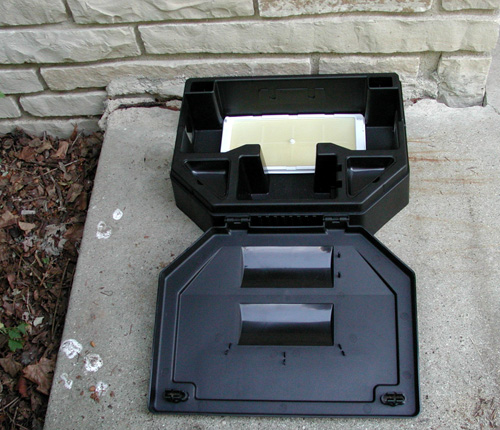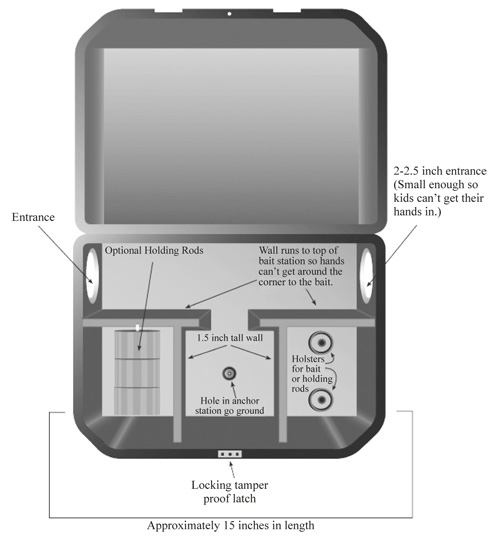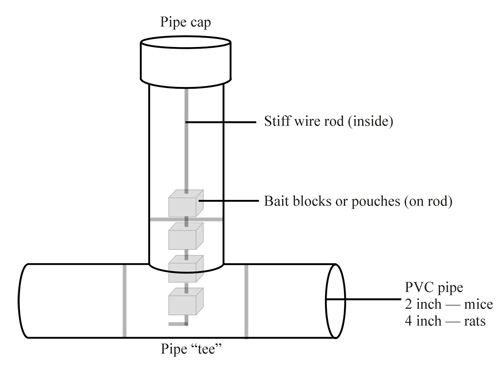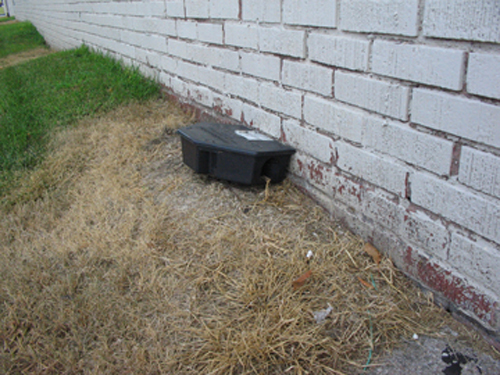G1646
Bait Stations for Controlling Rats and Mice
Bait stations are effective for controlling rats and mice. This NebGuide describes the design and use, correct placement, and selection of baits.
Stephen M. Vantassel, Wildlife Damage Project Coordinator
Scott E. Hygnstrom, Wildlife Damage Extension Specialist
Dennis M. Ferraro, Extension Educator
- Bait Selection
- Types of Bait Stations
- Building Your Own Bait Station
- Bait Station Placement
- Bait Station Maintenance
- Safety
- Acknowledgments
Toxic baits often are used to reduce damage caused by Norway rats (Rattus norvegicus) and house mice (Mus musculus). Using bait stations in rodent control increases both the effectiveness and safety of rodenticide use.
Bait Selection
Rodenticides are categorized according to their mode of action (Table I). Awareness of how rodenticides work is helpful in using them properly to obtain desired control.
| Table I. Rodenticides categorized by mode of action. | |
| Mode of Action | Anticoagulants |
| 1st Generation | warfarin diphacinone chlorophacinone |
| 2nd Generation | brodifacoum difethialone bromadiolone difenacoum |
| Non-anticoagulants | bromethalin cholecalciferol zinc phosphide |
Anticoagulants disrupt the ability of blood to clot. First-generation rodenticides require rodents to feed multiple times to receive a lethal dose. Second-generation toxicants can kill rodents after a single feeding. However, rodents feeding on second-generation rodenticides only succumb a day or two sooner. This delay in lethality prevents bait-shyness.
Non-anticoagulant rodenticides kill rodents by interfering with the nervous system (bromethalin), calcium levels in the blood (cholecalciferol), or by generating a toxic gas internally after ingestion (zinc phosphide).
Rodenticides are classified as General Use Pesticides (GUP) and Restricted Use Pesticides (RUP). A license is required to purchase RUPs. Many GUPs have the same active ingredients used in RUPs. The difference is GUPs generally are sold only in small quantities (1 pound or less) or in formulations, such as wax blocks or soft baits, that present lower risk to non-targets because rodents cannot relocate the toxicant easily.
Purchase enough toxicant to ensure continued feeding. This is especially important when using first-generation toxicants. In new and light infestations (e.g. a 1,000 square-foot home), five to seven containers should be sufficient. In severe infestations, many more will be required. While GUPs are more than adequate for most residential and small commercial situations, consider changing to a different active ingredient or consulting with a pest management professional (PMP) if the needed level of control is not being achieved in four to six weeks.
You can purchase larger quantities of rodenticides that are RUPs and different formulations, such as loose grain, tracking powder, pellet-grain mixtures, and water-soluble concentrates. These formulations provide PMPs additional tools to control especially difficult rodent problems. Liquid baits work well in locations where rodents have few water sources, such as granaries. Rats often will come to water stations because they need water daily unless they are feeding on moisture-rich food. Simply mix the dry concentrate with a measured amount of water as stated on the label to create an enticing rodent bait. Liquid baits are not recommended for the control of mice. Since many non-target animals drink water, receptacles containing liquid rodenticides should be used indoors, in non-residential settings, and be enclosed within bait stations to reduce hazards to pets, livestock, and wildlife.
Refer to NebGuides Controlling House Mice, G1105, and Controlling Rats, G1737, and http://icwdm.org for additional information on using baits to control these species.
Bait stations enhance the efficiency of rodenticide use by providing one or more of the following benefits:
- protect bait from moisture and dust;
- provide a protected place for rodents to feed, allowing them to feel more secure and consume more bait;
- keep non-target species, including pets, livestock, wildlife, and children away from toxic baits;
- permit bait placement in otherwise difficult locations given weather or potential hazards to non-target animals;
- help prevent the accidental spilling of bait; and
- offer the applicator easy access to bait to determine the amount of feeding by rodents, and for refilling.
Types of Bait Stations
Consumer Bait Stations
To protect people and non-target species, the United States Environmental Protection Agency (EPA) established more restrictive guidelines on the use of rodenticides by “consumers” (users other than professional or agricultural applicators) starting June 4, 2011. The EPA sought to further decrease exposure of children, pets, and wildlife to rodenticides. Since the risk of non-target exposure to toxicants varies by situation, the EPA created four different tiers of bait stations to designate different levels of protection (Table II). Consumers must choose stations appropriate to protect non-targets in their locale.
| Table II. Consumer rodenticide bait stations and levels of tamper- and weather-resistance, from Tier 1 (highest) to Tier 4 (lowest). | ||||
| Bait Station Capabilities | Tier 1 |
Tier 2 |
Tier 3 |
Tier 4 |
| Resistant to children Resistant to dogs Resistant to outdoor weather Resistant to indoor conditions |
Yes Yes Yes Yes |
Yes Yes No Yes |
Yes No No Yes |
No No No Yes |
Professional Bait Stations
Manufacturers have created several designs of refillable bait stations to meet the needs of PMPs and agricultural applicators who have been mandated to use them. The designs are based on whether the station needs to:
- Target rats or mice,
- Contain solid (loose pellets, pellet place packs, soft baits, and wax blocks) or liquid baits,
- Sustain indoor or outdoor use,
- Resist tampering, and
- Hold traps (snap and glue; Figure 1).
 |
| Figure 1. AEGIS™-RP Bait Station (Liphatech, Inc.) holding a glue board. Many manufactured bait stations are designed with the flexibility to be used with traps, glue boards, and toxicants. (Photo by Liphatech, Inc.) |
The EPA has established safety criteria that bait stations must fulfill before receiving the designation “tamper resistant” (PR Notice 94-7). Tamper resistant stations must be:
- Resistant to destruction or weakening by weather,
- Strong enough to prohibit entry or destruction by dogs and children under 6 years of age using their hands, feet, or objects in the environment,
- Capable of being locked or sealed,
- Equipped with rodent entrances that readily allow target animals access to baits but deny access to larger animals and birds,
- Capable of being anchored (and must be anchored when used),
- Equipped with internal structures for containing baits and minimizing spillage and tracking of bait outside of the station or into readily accessible parts of the station,
- Made of design and color not especially attractive to children, and
- Capable of displaying precautionary statements in a prominent location.
Manufacturers meet the safety criteria by constructing bait stations out of sturdy plastic. To prevent children from accessing the bait, some manufacturers have designed bait stations with two chambers that force rodents to take a 90° turn to access the bait (Figure 2). Other manufacturers use baffles or distance. Tamper-resistant stations must be secured to the floor, heavy patio stone, or wall to prevent the bait from being removed by shaking. Manufacturers have developed metal covers for stations at risk of damage by hoofed livestock, wildlife, or vehicle traffic.
 |
| Figure 2. Open bait station illustrating entrance holes, interior walls, holding rods, anchor points, and locks. (Image by UNL. ) |
Manufactured bait stations are available through vendors of farm and chemical supply stores or can be ordered through the Internet or pest management suppliers. Stations are sold with different features related to how they are anchored, cleaned, and opened. Landscape versions look like rocks and blend with overall surroundings. Consider several types of stations before making a purchase.
Building Your Own Bait Station
In light of the EPA ruling, users of GUPs no longer need to consider building their own bait stations, as bait is sold with accompanying stations. Licensed pesticide applicators, however, must decide whether they will purchase manufactured bait stations or build their own. If licensed pest control applicators prefer to build their own bait stations, it is necessary that homemade stations meet federally mandated standards of “tamper resistance” if placed where children or non-target animals have access (see Table II). Where children and livestock are present, the station should prevent unauthorized access and removal of the toxicant. Locks or concealed latches are recommended to increase the tamper-resistance of the bait station. Use sturdy materials to prevent damage to the station. Clearly label all bait stations with “POISON,” “RODENT BAIT — DO NOT TOUCH,” or a similar warning. In areas with non-English speaking groups, consider adding the warning in non-English languages as well. You can create your own warning labels on the Internet. Search for this free service by using the phrase “warning label generator.”
In secure areas, where the risk of non-target exposure is low, station design can be as simple as a board nailed at an angle between the floor and wall, or a 4-inch diameter PVC pipe (24 inches long for rats or 2-inch diameter for mice), into which bait can be placed (Figure 3). Boxes (10 x 6 x 2 inches high) are ideal for mice when used in secure indoor locations. More elaborate stations are completely enclosed and can contain liquid as well as solid rodent baits. Hinged lids allow convenient inspection of stations in permanent settings. Your design must take into account the label requirements and relative risk of the rodenticide for non-target exposure. Increase the margin of safety by being more restrictive than the label requires.
Simple, sturdy and weather-resistant “T-shaped” bait stations can be constructed using PVC pipe and fittings (Figure 3). They can be strapped to a wall with pipe straps or secured to a post with wire or zip ties. Bait is skewered on a stiff wire rod placed inside the vertical pipe. The cap can be “locked” on with a sheet metal screw. Lateral pipes can be made long enough to keep non-target animals such as raccoons from reaching the bait.
 |
| Figure 3. Homemade bait station. This station can be used with pellet or block bait. If using bait blocks, use a wire or long rod to hold bait in place. Warning: This station is suitable in secured locations only. (Image by Dee Ebbeka.) |
Bait stations should be large enough to allow several rodents to feed at once. Minimum standards apply for designing bait stations (Table III).
Construct your station with at least two openings on opposite sides. Rodents are more likely to enter a station if they sense an alternate escape route.
Many manufactured bait stations are designed to hold snap traps, glue boards, and rodenticides. Some stations hold liquid toxicants as well. Consider designing your bait stations to house multiple control tools.
| Table III. Minimum standards for bait stations for rats and mice. | ||||
Hole Size |
Length |
Width |
Height |
|
| Rats | 2¼” |
12¼” |
11.0” |
3.0-4.0” |
| Mice | ¾” |
5¼” |
3¾” |
1¼” |
Bait Station Placement
The quality and effectiveness of manufactured rodenticides are so high that any lack of consumption of toxicants by rodents usually is caused by human error. Rats and mice will not visit bait stations, regardless of their contents, if they are not located conveniently in areas of rodent activity. When possible, place the stations between the rodents’ food supply and their shelter. Position bait stations near rodent burrows, against walls, and along their travel routes. Look for signs of activity such as droppings, gnawing, tracks, and rub marks to identify sites to place bait stations. Norway rats will travel up to 400 feet from their nests, so rat stations can be placed 15 to 50 feet apart. It is important to be patient when controlling rats. Rats often are suspicious of new or unfamiliar objects. Do not be surprised if some rats wait up to two weeks before feeding at your bait stations or ignore them altogether. Do not use mouse-sized stations when rats are present as they can gnaw into mouse-sized stations and expose the toxicant. House mice seldom venture more than 50 feet from their nests or food, so place bait stations no more than 12 feet apart in areas where mice are active.
On farmsteads, placement of bait stations depends on building design and use. In swine confinement buildings, it may be possible to attach bait stations to wall ledges, or to the top of pen dividing walls. Bait stations also can be placed in attics or along walls in alleys where rodents are active (Figure 4).
 |
| Figure 4. Rat-sized bait station properly placed against the exterior wall of a building. (Photo by Stephen M. Vantassel.) |
Never place bait stations where livestock, pets, or other non-target animals can disturb them. Non-target poisonings can occur in unusual ways. A zoo once lost monkeys to poisoning after they ate cockroaches that had fed on rodenticides. Be especially cautious with loose and pelleted grain formulations because rodents frequently move them to unsafe areas. They also are easily spilled. Spilled bait is a potential hazard, particularly to smaller animals. Rodent baits, regardless of formulation, are poisonous to all animals in varying degrees. Swine and dogs especially are susceptible to anticoagulants. Fortunately, Vitamin K is available as an antidote.
Permanent bait stations can be placed inside buildings and along the outside walls of buildings that are not rodent-proof. It is illegal to place stations more than 100 feet away from human-made structures. Placements beyond 50 feet increases the threat to non-target species, while not substantially increasing control of target species.
Avoid placing bait stations in areas exposed to afternoon sunshine. Internal temperatures of bait stations exposed to the sun can be 20 to 30 percent hotter than the surrounding air — hot enough to melt bait blocks. If stations must be placed in direct sunlight, choose gray- or white-colored stations and use non-paraffin-based toxicants.
Leave rat-sized bait stations in place after a successful control program. If rat problems reoccur, rats are more likely to enter stations that have been part of the “landscape” than newly placed ones. Be aware, however, that plastic stations become brittle over time, especially when exposed to sunlight. Check the integrity of stations and replace weak stations before re-filling them. Stations with living hinges (a thin line of plastic capable of bending) are less durable than stations with moving hinges.
Bait Station Maintenance
After installing bait stations to eliminate an infestation, check them daily and add fresh bait as needed. After a short time, rodent numbers and feeding will decline, and surveillance of stations will be necessary only every two to four weeks. Monitor bait stations regularly to ensure an uninterrupted supply of fresh bait. Rats and mice often reject spoiled or stale foods. Provide enough fresh bait for rodents to eat sufficiently, but do not overfill. Empty, clean, and refill the bait station with fresh bait, when bait becomes moldy, musty, soiled, or insect infested. If the bait was contained in a single-use station, dispose of the station and its contents according to the directions on the label.
When performing maintenance on reusable stations, always wear appropriate safety equipment as specified by the label, including disposable gloves. Avoid excessive cleaning, as rodents are more likely to enter a bait station containing the odors and droppings of previous visitors. If cleaning must be performed, use the following procedure:
- Open bait station,
- Empty old bait or place aside if bait is still fresh enough to be used,
- Spray interior with any common disinfectant or 10 percent bleach solution, being sure to dampen any droppings,
- Let dry,
- Empty contents into plastic bag and dispose according to the label, and
- Refill station.
If ants are a problem, treat the interior of the station (especially the bait tray) with a low-odor, liquid pyrethroid insecticide. Let the insecticide dry before filling the station with toxicant. Insecticides likely will not deter rodents, provided that the insecticide is applied at label rates. Another option is to sprinkle insecticide granules on and around the immediate area before placing the station. Never directly treat rodent bait with insecticide. Always follow all label directions for the products you are using.
Safety
Follow all safety guidelines when handling pesticides. Wear neoprene, nitrile, or vinyl gloves when handling toxicants. Avoid breathing dust when pouring granulated or pelletized pesticides. Don’t smoke, eat, or drink when handling pesticides. When finished applying toxicants at a location, wash your hands and face thoroughly, and change your clothes. These precautions also are helpful in protecting yourself from biological hazards, such as salmonella. Avoid stirring up dust from inside the station. Deer mice, a species known to carry hantavirus, commonly take up residence inside empty stations. Hantavirus can be disinfected with a 10 percent bleach solution or Lysol®. For more safety information please consult the NebGuide Controlling House Mice, G1105 http://www.ianrpubs.unl.edu/sendIt/g1105.pdf, or visit the website for the Centers for Disease Control (http://www.cdc.gov).
Acknowledgments
We thank Robert Corrigan, RMC Pest Management Consulting; Ted Bruesch, Liphatech, Inc.; Buzz Vance, Nebraska Department of Agriculture; and Gary Zoubek, University of Nebraska–Lincoln Extension for providing useful suggestions that improved this NebGuide.
This publication has been peer reviewed.
Disclaimer Reference to commercial products or trade names is made with the understanding that no discrimination is intended of those not mentioned and no endorsement by University of Nebraska–Lincoln Extension is implied for those mentioned. |
This publication has been peer reviewed.
Visit the University of Nebraska–Lincoln Extension Publications website for more publications.
Index: Wildlife Management
Wildlife Damage Control
2006, Revised December 2012